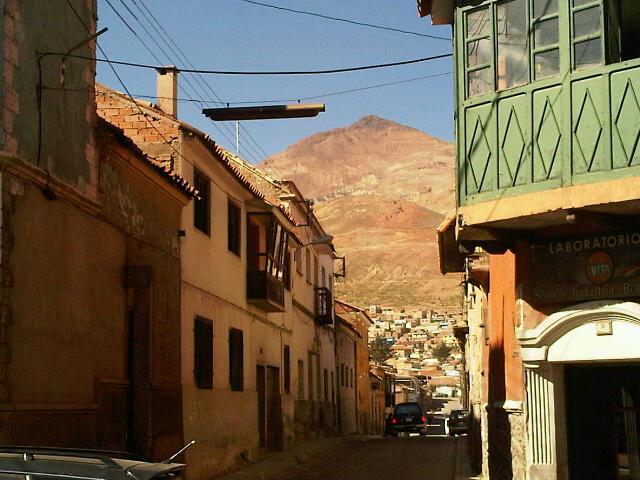AFTER weeks dodging mosquitoes in Brazil it has been fantastic not having to lather myself in insect repellent morning, noon and night for the last few days.
The temperatures have dropped massively and luckily we are now at cities too high for evil mozzies.
Instead we have had to get ourselves used to the high altitudes and getting out of breath just doing a 10 minute walk uphill.
But some of the landscapes we have seen have been breathtaking and we saw lots of llamas along the way.
Potosi
WE had amazing views of the mountains during the four hour drive to Potosi.
With our luggage strapped to the top of the bus and about five Bolivians squeezed into the drivers cab it’s obvious pretty much anything goes here. The roads were narrow and windy and at times we drove along the edge of a cliff with a long drop down.
Potosi is the highest city in the world at 4,000 metres above sea level.
The indigenous people in the city are quechuans, speaking Quechua rather than Spanish.
I felt slightly light headed and dazed as we landed in Potosi. It felt strange being at altitude and I felt like I had less energy to do things. Even just a short walk to a shop near the hotel left you breathless and gasping for air.
There is very little to see in Potosi except the mines. The mines once produced enough silver for the continent’s currency. But now they produce minerals such as zinc, fools gold, copper and lead. That, and the number of tourists visiting the mines, keeps the economy going.
Kitted out in ridiculous yellow protective suits, gum boots and surgical masks we were driven to one of the 280 mines that still exist.
Miners in the city work in some of the most difficult conditions for just 500 bolivianos a month (£50). To get them through they chew coca leaves all day which are used to make cocaine and numb all their feelings of tiredness, hunger and claustrophobia.
On top of that they smoke pure tobacco cigarettes and sip on 92 per cent alcohol to get them through the dark hours underground.
Entering the mine I kept telling myself I would only go a part way through for an hour just to see what it’s like. It wasn’t long before we were crouching and squeezing ourselves into small holes. At times we had to crawl through tiny spaces and climb dodgy ladders, and all the while I struggled to breathe. Under the mines it was suffocating as it got warmer underground and dusty. It was a huge relief when we got to points where we could stand up straight and stretch.
We were under there for almost three hours and I was surprised I stuck it out. Knowing there was a way out was the only thing that kept me going.
Visiting the mine was an experience. It was interesting to see what the miners face each day and made me grateful for the spacious office I go to each day…even if the heating/air-conditioning is buggered on most days.
Uyuni
THIS strangely named town was in the middle of nowhere and took us another six hours to get to.
The Tonito Hotel we were staying at is renown for its great pizzas so there was no question about where we were going to eat on our first night. The hotel’s pesto and mozzarella sandwich was pretty legendary too.
The biggest attraction in Uyuni is the Salar de Uyuni – the salt flats. And that is pretty much all the tourists come to see.
Unfortunately the salt flats had experienced major rain before we got there so much of it was under water. It also meant our planned night staying at the salt hotel had to be cancelled.
We got into some four wheel drives for the journey to the salt flats and the views were incredible.
The salt was like a white, white beach and the sky was so blue. It was beautiful.
It would have been amazing to see without the water but even with the floods it was a lovely sight.
We spent a good few hours taking photos, trying to be creative with the shots we got and just splashing around. Salt got absolutely everywhere!
For lunch, the rest of the group had a delightful dish of llama, salad and quinoa while I had a tortilla. I think they all enjoyed it. Some said it tasted like chicken.
We had hoped to see the sun setting over the salt flats, which would have been amazing, but unfortunately we had to catch our overnight bus to La Paz. Major disappointment!
***************
The bus to La Paz was possibly one of the worst journeys we had done since we got here. It shook from side to side, there was so much dust coming through gaps in the windows and occasionally there was a harsh jolt that got us looking worried that we wouldn’t make it to La Paz alive. Then to make it worse one of the back tyres blew so we had an impromptu stop to change a tyre.
It was a total nightmare! I couldn’t even sleep.
To avoid going to the loo during the 10 hour drive many of us tried to drink as little water as possible. But that proved difficult when you were breathing in stupid amounts of dust and fumes from outside.
In one day I experienced all forms of going to the loo in Bolivia…. A hole in the ground, a side of the road job and a proper toilet that was flooded with god knows what and stank so much I was heaving.
But like I keep saying….it’s all part of the adventure!




One thought on “Mines, salt and being at high altitudes”
great photographs!